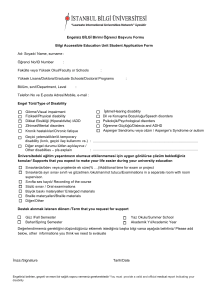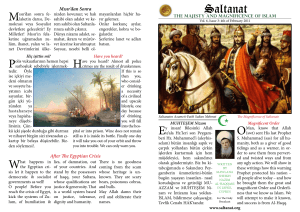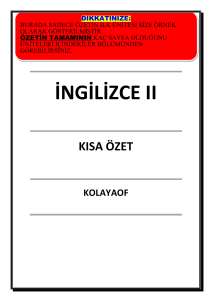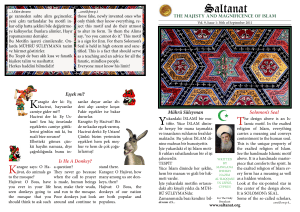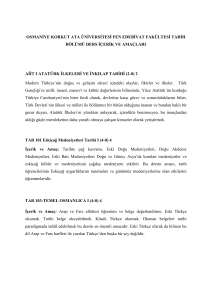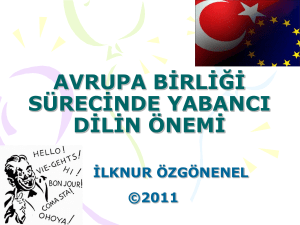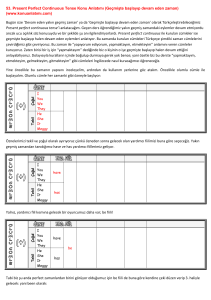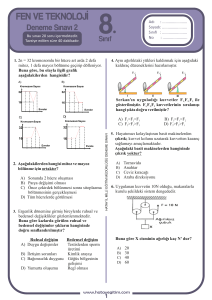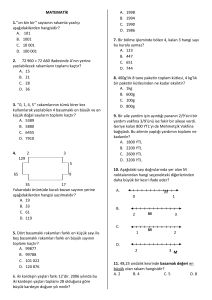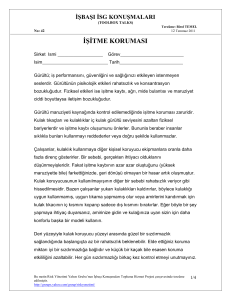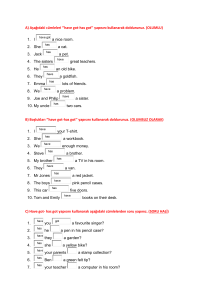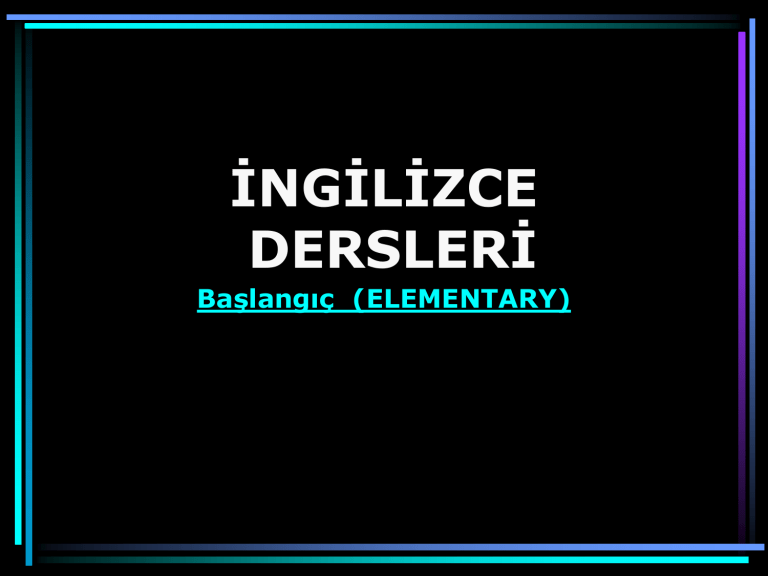
İNGİLİZCE
DERSLERİ
Başlangıç (ELEMENTARY)
İNGİLİZCE ŞAHIS ZAMİRLERİ
I
Ben
YOU
HE
SHE
IT
Sen
O (Erkekler için kullanılır)
O (Dişiler için kullanılır)
O (Cansızlar ve hayvanlar
We
You
They
Biz
Siz
Onlar
için kullanılır)
Örnekler
1.
2.
3.
4.
5.
6.
7.
8.
I am a student.
You are a teacher.
He is a policeman.
She is a housewife.
It is a dog.
We are doctors.
You are politicians.
They are
businessmen.
1.
2.
3.
4.
5.
6.
7.
8.
Ben bir öğrenciyim.
Sen bir öğretmensin.
O bir polistir.
O bir ev hanımıdır.
O bir köpektir.
Biz doktoruz.
Siz siyasetçisiniz.
Onlar iş adamıdır.
TO BE (am-is-are) olmak fiilinin
Şahıslara göre kullanımı
I am....................
Ben............................im.
You are...............
Sen............................sin.
He is...................
O (Erkek)...................dır.
She is..................
O (Bayan)...................dır.
It is.....................
O (Hayvan, Eşya)........dır.
We are................
Biz...............................iz.
You are...............
Siz...........................siniz.
They are..............
Onlar......................dırlar.
TO BE Fiilinin Simple Present Tense
-Geniş Zamana Göre- Çekimi
Affirmative
(Olumlu)
Negative
(Olumsuz)
Interrogative
(Soru)
Long form
(Uzun Şekil)
Short Form
(Kısa Şekil)
Long form
(Uzun Şekil)
Short Form
(Kısa Şekil)
Question Form
(Soru Şekli)
I am
I'm
I am not
I'm not
Am I?
You are
You're
You are not
You aren't
Are You?
He is
He's
He is not
He isn't
Is he?
She is
She's
She is not
She isn't
Is she?
It is
It's
It is not
It isn't
Is it?
We are
We're
We are not
We aren't
Are we?
You are
You're
You are not
You aren't
Are you?
They are
They're
They are not
They aren't
Are they?
To Be Fiilinin Soru ve Kısa Cevap Şekilleri
Question –
Soru
Positive Olumlu
Negative Olumsuz
Are you?
Yes, I am.
No, I'm not.
Am I?
Yes, you are.
No, you aren't.
Is he?
Yes, he is.
No, he isn't.
Is she?
Yes, she is.
No, she isn't.
Is it?
Yes, it is.
No, it isn't.
Are we?
Yes, you are.
No, you aren't.
Are they?
Yes, they are.
No, they aren't.
Examples - Örnekler :
1) Are you from
Istanbul?
-Yes, I am.
2) Is Jenny
eleven years old?
-No, she isn't.
3) Is George in
the park?
-No, he isn't.
4) -Are Nick and
-Yes, they are.
Jenny brother and
sister?
Articles (a/an/the)
Türkçe'de karşılığı tanımlık olan article
belirli (definite), belirsiz (indefinite)
olamak üzere ikiye ayrılır.
• INDEFINITE ARTICLE - Belirsiz Tanımlık
– A/an belirsizlik tanımlık olarak kullanılır. İkisi
de aynı anlama sahiptir. Sadece sayılabilir tekil
(countable singular nouns) isimlerle kullanılır.
Sessiz harfle başlayan isimler a, sesli harfle
başlayanlar ise an alır.
Examples - Örnekler :
a book
an egg
a banana
an actor
a brother
an arm
a lesson
an eye
a pencil
an apple
Articles (Devam)
• DEFINITE ARTICLE - Belirli
Tanımlık
• Belirli bir nesneden
bahsediyorsak the kullanılır.
The sayılabilir tekil - countable
singular - ya da
sayılamaz uncountable - isimlerin
hepsiyle kullanılır.
Examples - Örnekler :
the book
the exercise
the table
the old people
the doctor
the actor
the boy
the apple
the children
the orange
Plurals of nouns - İsimlerin çoğul
halleri
• Regular Plurals - Düzenli
Çoğullar
– İngilizce'de
isimler
sonuna
getirilen "s" takısıyla tekil halden
çoğul hale getirilir. Ancak bazı
isimlerin
sonundaki
harflerin
özelliğine göre değişiklik gösterir.
Examples - Örnekler :
Singular -Tekil
Plural-Çoğul
a book - (bir) kitap
books -kitaplar
a pen
pens
a pencil
pencils
a boy
boys
a girl
girls
Irregular plurals - Düzensiz çoğullar
• İngilizce'de isimleri çoğul hale
getirirken bütün kelimelerin
sonuna "s" takısı gelmez.
Bazı kelimelerin kendine has
çoğul şekilleri vardır.
Bunlar çok az olup, çok
kullanılan isimlerdir.
Examples - Örnekler :
Singular - Tekil
Plural - Çoğul
one child - bir çocuk
children - çocuklar
one man - bir adam
men
one woman- birkadın women
one person- birkişi
people
one tooth -
bir diş
teeth
one foot -
bir ayak feet
one mouse- bir fare
mice
Possessive Adjectives
-İyelik Sıfatları İyelik sıfatları, isimlerden önce gelerek onları nitelerler.
my
benim
your
senin
his
onun (erkekler için
kullanılır)
her
onun (dişiler için
kullanılır)
its
onun (cansızlar ve
hayvanlar için)
our
bizim
your
their
sizin
onların
Examples - Örnekler :
my name
benim adım
your book
senin kitabın
his ball
onun topu
her skirt
onun eteği
its tail
onun kuyruğu
our school
bizim okulumuz
your car
sizin arabanız
their family
onların ailesi
Genitive apostrophe "s" - iyelik eki -
• İngilizce’de insan, hayvan, yer ve zaman
isimlerine iyelik anlamı
vermek, bir şeyin kime ait olduğunu
belirtmek için kullanılır.
İstisnalar dışında eşyalar için kullanılmaz.
Türkçe’deki tam karşılığı; -ın, -in,-un, -ün;
-nın, -nin, -nun, -nün ekleridir.
Tekil isimlerde ’s şeklinde çoğul isimlerde
de sadece s’ şeklinde gelir. Düzensiz
çoğullarda (irregular plurals) da yine ’s
olarak kullanılır.
Examples - Örnekler :
Singular Form
Plural Form
cat’s tail-kedinin kuyruğu
cats’ tails - kedilerin kuyrukları
girl’s bag - kızın çantası
girls’ bags - kızların çantaları
man’s hat - adamın şapkası
men’s hats adamların şapkaları
child’s toys-çocuğun oyuncağı
children’s toys çocukların oyuncakları
Ayşe’s pen - Ayşe'nin kalemi
women’s room - kadınların
odası
Jane’s school
my brothers' names kardeşlerimin isimleri
- Jane'inokulu
George’s father George'nin babası
mice’s hole farelerin deliği
Demonstrative - İşaret Sıfatları
This, that, these, those
• Belirtme sıfatlarının Türkçe karşılıkları
• “this=bu”
“that=o,şu”
demektir.
Ancak, İngilizce’de, işaret edilen şeyin
tekil veya çoğul olma durumuna bağlı
olarak işaret sıfatları da tekil ve çoğul
şekiller alır
Demonstrative - İşaret Sıfatları
This, that, these, those
• Yakın şeyleri işaret ederken
Tekil şeyler için
THIS: this book,
Çoğul için
THESE: these books
• Uzak şeyleri işaret ederken
Tekil için
THAT: that book
Çoğul şeyler için THOSE: those books
• İşaret sıfatları , tek başına özne şeklinde de kullanılır.
Örnek: This is a pencil.
These are pencils.
That is a pencil.
Those are pencils
Examples - Örnekler :
Singular
Plural
these
this (bu)
(bunlar)
those
that (o,şu) (onlar,şunl
ar)
Examples - Örnekler :
Singular
this book
this pencil
this man
this lemon
this child
that person
that cat
that school
Plural
these books
these pencils
these men
these lemons
these children
those people
those cats
those school
Have Got
• “Have Got” fiili İngilizce’de
sahip olmak anlamını verir.
Şahıslara göre cümledeki
çekimi ise şöyledir;
Üçüncü tekil şahıslarda he,
she, it has got şeklini alır.
Examples - Örnekler :
Affirmative
(Olumlu)
Negative
(Olumsuz)
Interrogative
(Soru)
Long form
(Uzun Şekil)
Short Form
(Kısa Şekil)
Long form
(Uzun Şekil)
Short Form
(Kısa Şekil)
Question Form
(Soru Şekli)
I have got
I’ve got
I have not got
I haven’t got
Have I got?
You have got
You’ve got
You have not
got
You haven’t got
Have you got?
He has got
He’s got
He has not got
He hasn’t got
Has he got?
She has got
She’s got
She has not got
She hasn’t got
Has she got?
It has got
It’s got
It has not got
It hasn’t got
Has it got?
We have got
We’ve got
We have not
got
We haven’t got
Have we got?
You have got
You’ve got
You have not
got
You haven’t got
Have you got?
They have got
They’ve got
They have not
got
They
haven’tgot
Have they got?
Examples - Örnekler :
Long Form
Short Form
Negative
I have got a car
I’ve got a car
I haven’t got a
car
You have got a
brother
You’ve got a
brother
You haven’t got
a brother
He has got a pen He’s got a pen
He hasn’t got a
pen
She has got a
book
She’s got a book
She hasn’t got a
book
It has got a tail
It’s got a tail
It hasn’t got a
tail
COUNTABLE AND UNCOUNTABLE
NOUNS
• İngilizce’de isimler sayılabilen countable ve sayılamayan - uncountableisimler diye ikiye ayrılır.
Sayılabilirlik ve sayılamazlık
kavramları Türkçe ve İngilizce’de
farklı olarak kabul edilmektedir.
Bu nedenle sayılabilirlik
kavramlarını Türkçe mantığına
göre düşünmemek gerekir
Countable Nouns Sayılabilen İsimler - :
• Sayılabilen isimler, sayma sayıları ile birer birer
sayılıp miktarı daha kesin olarak ifade edilebilen
isimlerdir.
A ve an
gibi belirleyicileri sadece sayılabilir
isimlerle kullanabiliriz. “Birkaç, biraz” anlamına
gelen some hem sayılabilen hem de sayılamayan
isimlerle
llanılar.
Sayılabilen bir nesneden birden çok sayıda
olduğunu belirtirken (two, three,four...veya some
şeklinde sayısı belirtilirken) nesnenin de çoğul
hale getirilmesi gerekir
Examples - Örnekler :
Singular
Plural
A lemon (Bir
limon)
A boy
two lemons (İki
limon)
three boys
An apple
four apples
An egg
some eggs
A dog
some dogs
A room
two rooms
Examples - Örnekler :
two pens
We’ve got two pens.Bizim iki kalemimiz var
An apple
three apples
You’ve got three
apples.Senin üç tane elman var
A book
four books
He’s got four books.Onun dört kitabı var
five children
She’s got five children.Onun [bayan]beş
çocuğu var.
A pen
A child
An orange
some oranges
I’ve got some oranges.Benim birkaç portakalım
var.
Yukarıdaki örneklerde görüldüğü gibi adet olarak birden fazla sayıda bir isimden söz
ettiğimiz için “ismi” çoğul şekliyle belirttik. Bu kural Türkçe’de uygulanmayan bir kural
olduğu için Türkçe karşılıklarında isim, tekil olarak gösterilmiştir
Uncountable Nouns
(Sayılamayan İsimler):
• İngilizce’de soyut isimler, madde isimleri
gibi bazı isimler sayılamayan isimler
(uncountable nouns) olarak adlandırılır.
Sayılamayan isimler her zaman tekildirler
ve a/an artikelleri ile kullanılmazlar ve
sonlarına çoğul s takısını almazlar. Onun
yerine some, a little, little, a lot of gibi
ayrıntılı açıklamasını ileride göreceğimiz
miktar bildiren sıfatlarla kullanılırlar.
Examples - Örnekler :
milk (süt)
some milk-biraz süt
cheese (peynir)
some cheese-biraz
peynir
water (su)
some water-biraz su
bread (ekmek)
some bread-biraz
ekmek
time (zaman)
some time-bir süre
time (zaman)
some meat-biraz et
Prepositions
(Edatlar/İlgeçler) I
•Tek başlarına anlamları olmayan, ancak aralarına girdikleri
sözcük çümlecik ya da deyişlerin anlamlarını kuvvetlendiren
ya
da belirleyen sözcüklerdir. Çeşitlere ayrılırlar
Prepositions of place - yer adatları :
in, on, under, next to, behind
Nesnelerin yerlerini belirtmek için yer edatlarını kullanırız.
İngilizce’de çok sayıda yer edatı vardır. Bunlardan bazılarını
inceleyelim.
Examples - Örnekler :
in the box
in: içinde
(kutunun içinde)
on the box
on: üstünde
(kutunun üstünde)
under the box
under: altında
(kutunun altında)
next to the box
next to: yanında
(kutunun yanında
behind the box
behind: arkasında
(kutunun arkasında)
There is / There are
•
Nerede neyin, ya da nerede kimin var olduğunu
(ya da var olmadığını) anlatmaya yarayan ifade şeklidir.
Interrogati
ve
(Soru)
Affirmative
(Olumlu)
Affirmative
(Olumlu)
Negative
(Olumsuz)
Negative
(Olumsuz)
Long form
Short form
Long form
Short form
Question
form
Singular
There is
There’s
There is
not
There isn’t
Is there ?
Plural
There are
*
There are
not
There
aren’t
Are there ?
*Thereare yapısının olumlu şeklinin kısa yazılışı yoktur
Interrogative (Soru)
Short Answer (Kısa Cevap)
Affirmative
Negative
Is there ...........?
Yes, there is.
No, there isn’t
Are there.........?
Yes there are.
No, there aren’t
Examples - Örnekler :
Affirmative
Negative
Question
There is a
school.
There isn’t a
school.
Is there a school
?
There is a
woman.
There isn’t a
woman.
Is there a
woman?
There are two
dogs
There aren’t two Are there two
dogs.
dogs?
There are two
trees.
There aren’t two Are there two
trees.
trees?
Examples - Örnekler :
Affirmative Sentences
1) There is a cat on the box.
2) There is a dog in the garden.
3) There is a boy behind the car.
4) There is a picture on the wall.
5) There are houses next to the park.
6) There are trees and flowers in the park.
7) There are some people behind the door.
8) There are two children next to the apartmen
Examples - Örnekler :
Questions
Short Answers
1) Is there a cat on the box?
Yes, there is. / No, there
isn’t.
2) Are there girls in this
class?
Yes, there are. / No, there
aren’t
3) Is there a dog in the
garden ?
Yes, there is. / No, there
isn’t.
4) Is there a picture on the
wall ?
Yes, there is. / No, there
isn’t.
5) Are there children in the
room?
Yes, there are. / No, there
aren’t.
Possessive Pronouns Used as Nouns
(İsim Olarak Kullanılan İyelik Zamirleri)
• Önceki derslerde isimlerden önce gelerek
onları niteleyen iyelik sıfatlarını
(Possesive Adjectives) görmüştük (5.
Ders). Bu derste de iyelik sıfatları ile
bağlantılı olarak iyelik zamirlerini
(Possesive Pronouns) inceleyelim. İyelik
zamirleri tek başına bir isim (noun)
yerine kullanılabilirler. İyelik sıfatları
isim ile birlikte kullanılırken, iyelik
zamirleri tek başlarına hem iyelik
sıfatının hem de ismin yerini tutarlar
Examples - Örnekler :
Possessive Adjectives
(İyelik Sıfatları)
Possessive Pronouns
(İyelik Zamirleri)
my
(benim)
mine
(benimki)
your
(senin)
yours
(seninki)
his
(onunki -erkek-)
(onunki -dişi-)
his
(onun -erkek-)
her
(onun -dişi-)
hers
its
(onun)
*
our
(bizim)
ours
(bizimki)
your
(sizin)
yours
(sizinki)
their
(onların)
theirs
(onlarınki)
*"Its" iyelik sıfatının iyelik zamiri olarak karşılığı yoktur.
Examples - Örnekler :
Possesive
Adjective + Noun
=
Possesive Pronoun
1) This is my book.
(Bubenimkitabımdır.)
This book is mine. :
(Bu kitap benimki dir.)
This is mine.
Bu benimki dir.)
2) These are my books.
(Bunlar benim
kitabımdır.)
These books are mine. :
(Bu kitaplar benim [kiler]
dir.
These are mine
(Bunlar benim [kiler] dir.
3) This is your pencil.
(Buseninkalemindir.)
(Busizinkaleminizdir
This pencil is yours. :
(Bu kalem seninki dir senindir-.)
This is yours.
(Bu seninki dir - sizinkidir.)
4) These are his children.
(Bunlar onun
çocuklarıdır.)
These children are his. :
(Bu çocuklar onun [kiler]
dir
These are his.
(Bunlar onun [kiler] dir.
5) That is her skirt.
(Şuonuneteğidir.)
That skirt is hers. :
(Şu etek onunki dir.)
That is hers.
(Şu onunki dir.)
6) Those are our bags.
(Şunlarbizimçantamızdır.
Those bags are ours.
(Şu
çantalar bizim[kiler]dir-.)
Those are ours.
Şunlarlar bizim[kiler]dir-.)
7) These are their pictures.
(Bunlaronların.resimlerid
ir.)
These pictures are theirs.
(Bu resimler onların [kiler]
dir.
These are theirs.
Bunlar onların [kiler] dir
Adjectives
a) Position of Adjectives
İngilizce’de sıfatlar iki şekilde kullanılırlar.
a) İsimlerden önce:
A red apple;
Big, blue eyes
b) Bir fiilden sonra:
This man is fat.
Ahmet is good.
Adjectives
Examples (Örnekler):
1)
2)
3)
4)
5)
a
a
a
a
a
thick book
thin girl
short boy
big orange
tall man
This book is little..
These bags are small..
The house is old..
Your father is young..
The children are happy..
Adjectives
b) Nationality Adjectives
(Milliyet Sıfatları)
Country
(Ülke )
America
Egypt
England
France
Germany
Greece
Italy
Spain
Turkey
Adjective / Language
(Sıfat Hali /
Dil
)
American
Egyptian
English
French
German
Greek
Italian
Spanish
Turkish
Examples - Örnekler :
1) A Spanish girl
2) Two American ladies
3) A Turkish man
4) The Turkish language
5) The German language
Mehmet is Turkish.
Carlo is Italian.
Dimitris is Greek.
Kate is English.
Hermut is German.
Not: İngilizce’de ülke, dil ve milliyet sıfatları büyük
harfle yazılır.
The Simple Present Tense (Geniş
Zaman) I
Her zaman yaptığımız işleri,
alışkanlık, gelenek, görenek
ve olayları anlatmakta
kullandığımız Geniş Zaman
( The Simple Present Tense)'da
şahıslar iki gruba ayrılır
The Simple Present Tense (Geniş
Zaman) I
1. Grub
I
: Ben "Birinci tekil şahıs"
You : Sen "İkinci tekil şahıs"- Siz
"İkinci çoğul şahıslar"
We : Biz
"Birinci çoğul şahıslar"
They : Onlar "Üçüncü çoğul şahıslar"
2. Grub (3. tekil şahıslar)
He
She
It
The Simple Present Tense (Geniş
Zaman)
Grub özneleri (I, you, we, ve they) ile birlikte fiil'in
birinci
yani temel hali (verb 1) kullanılır.
Geniş zamanın olumlu cümlelerinde yardımcı fiil
(helping verb). kullanılmaz.
Cümleyi olumsuz yaparken DO"Yapmak" fiil'i yardımcı
fiil olarak kullanılır.
Özne ile fiil arasına do ve not (kısaca don’t) kelimelerini
getirilir.
not olumsuzluk ekidir.
Soru şeklinde ise cümlenin başına do kelimesini
getirilip ardından özne, yüklem (fiil) ve diğer
tamamlayıcı öğeleri
(tümleçler = complements) sıralanır.
The Use of The Simple Present Tense
(Geniş Zamanın Kullanımı)
• * İngilizce’deki "The Simple
Present Tense"in karşılığı "Geniş
Zaman"dır.
1-Simple Present Tense tekrar
edilen fiileri (eylemleri) anlatmak
için kullanılır.
Bu kullanımda çeşitli sıklık
zarflarına (adverbs of frequency)
yer verilir.
The Use of The Simple Present Tense
(Geniş Zamanın Kullanımı)
• every day: her gün
I walk to school every
day.
• on weekdays: hafta içi I go to school on
weekdays.
• every week: her hafta I visit my family every
week.
• every morning: her sabah I have breakfast every
morning.
The Use of The Simple Present Tense
(Geniş Zamanın Kullanımı)
-Geçerliliğini yitirmeyen, değişmeyen
gerçekleri ifade etmek için yine The
Simple Present Tense kullanılır.
Example: Students wear uniforms.
* Geniş Zaman’da love (sevmek), hate
(nefret etmek), like (hoşlanmak,
sevmek), dislike (sevmemek,
hoşlanmamak) gibi fiilleri kullanırız.
The Use of The Simple Present Tense
(Geniş Zamanın Kullanımı)
Examples:
1)
2)
3)
4)
I like school.
( Okulu severim )
I like apple.
( Elmayı severim )
I love people.
( İnsanları severim )
I hate cities.
( Şehirleri sevmem.
[Şehirlerden nefret ederim]
The Simple Present Tense (Geniş
Zaman) II
Simple Present with he, she and it
He
She
It
Mary
My father gibi üçüncü tekil şahıslardan sonra
Yükleme (s, es, veya ies) takıları ilave edilir.
Diğer şahısların olumsuz ve soru yapımında
kullanılan DO yardımcı fiil yardımcı fiili burada
DOES haline dönüşür.
The Simple Present Tense (Geniş
Zaman) II
Affirmative
(Olumlu):Subject + V1 + s(es,ies) + Complements
Negative (Olumsuz): Subject + does + not
(=doesn't) + V1 +Complements
Question
(Soru) : Does
+ Complements
+
Subject
V1
The Simple Present Tense (Geniş
Zaman) II
Affirmative
Negative
Interrogative
Long form
Short form
He works.
([O] çalışır.)
He does not
work.
([O]
çalışmaz.)
He doesn’t
work.
([O] çalışır
mı?)
Does he
work?
She works
She does not
work
She doesn’t
work
Does she
work?
It works
It does not
work
It doesn’t
work.
Does it
work?
Ders 15
Sonu ch, o, ss, sh ve x harfleri ile biten fiilere “es” takısı eklenir.
Examples (Örnekler):
1) watch
:izlemek
He / She / It watches.
(O
izler.)
2) Do
:yapmak
He / She / It does.
(O yapar.)
3) go
:gitmek
He / She / It goes.
(O gider.)
4) miss :özlemekk
He / She / It misses.
(O özler.)
5) wash
:yıkamak
He / She / It washes.
(O
yıkar.)
6) mix :karıştırmak
He/ She / It mixes.
(O karıştırır.)
Ders 15
Fiilin sonu y ile bitiyorsa ve y'den önce
ünsüz(consonant)varsa, fiilin sonundaki y, i’ye dönüşerek
kelimenin sonuna es getirilir. Dolayısıyla ek ies şeklinde
dönüşür.
Examples :
try
: uğraşmak
He / She / It tries.
(O uğraşır.)
carry
:taşımak
He / She / It carries.
(O taşır.)
cry
:ağlamak
He / She / It cries.
(O ağlar.)
Ders 15
Ancak fiilin sonundaki y’den önceki ses, ünlü (vowel; a, e,
i, o, u) bir harf ise, çekimlenirken sadece s alır.
Example (Örnek):
play
:oynamak He/She/Itplays.
O oynar.
Examples:
It flies.
It doesn’t fly.
The cat sleeps.
The cat doesn’t sleep.
She likes school.
She doesn’t like school.
She speaks Italian.
She doesn’t speak Italian.
Ayşe cleans her house.
Ayşe doesn’t clean her house.
The Simple Present Tense III
The Simple Present Tense in yes / no
questions
Geniş zamanda evet / hayır sorularının
kullanımı :
I, you, we ve they zamirlerinin geniş
zamandaki yardımcı fiilinin do, üçüncü
tekil şahıs olarak adlandırılan he, she, it
zamirlerinin de yardımcı fiilinin does
olduğunu önceki derslerimizde
görmüştük. Dolayısıyla bu soru cümleleri
ve onlara verilen kısa yes / no cevapları
da buna göre şekillenir.
Questions and Short Answers in The Simple Present
Tense
Geniş Zamanda Sorular ve Kısa Cevapları
Question
Positive Short Answer
Negative Short Answer
Do I work?
Yes,
you
do.
No,
you
Do you work?
Yes,
I/we do.
No,
I/we don’t.
Do we work?
Yes,
you
do.
No,
you
don't
Do they work?
Yes,
they
do.
No,
they
don’t
Does he work?
Yes,
he
does.
No,
he
doesn’t.
don't
The Simple Present Tense in yes / no questions
Geniş zamanın evet / hayır sorularında incelenişi
Examples :
Do you like your teacher ? Yes, we do.
Do they speak Turkish ? Yes, they do.
Does he eat meat?
Does she go to school ?
Does it fly ?
No, we
don’t.
No, they don’t..
Yes, he does.
No, he doesn’t.
Yes, she does. No, she doesn’t.
Yes, it
does. No, it
doesn’t.
Some"Wh" Questions (Birkaç "Wh-Bilgi-" Sorusu)
what, who, how, where, when
•
What: Ne, neyi, neye
Example: What is this ?
•
Who: Kim
Example: Who is this ?
•
How: Nasıl
Example: How is this apple ?
How is she ?
•
Where: Nerede, nereye
Example: Where is the book?
Where is he?
•
When: Ne zaman
Example: When is the holiday? When is it?
What is it ?
Who is he ?
What are they ?
Who are they ?
How are they
Where are they ?
When is his birthday?
what, who, how, where, when
• Example:
We play football in the garden Sundays.
((Biz) Pazar günleri bahçede futbol oynarız.)
Do you play football ? ( Futbol oynar mısınız?)
• What do you play ?
(Ne oynarsınız?)
• Where do you play ? (Nerede oynarsınız?)
• When do you play ? (Ne zaman oynarsınız?)
Other Examples (Diğer Örnekler):
1.
2.
3.
4.
5.
6.
What are there on the table
When do you get up
Where do you live
How do you go to school
Who is your favourite singer
Where are your friends
Prepositions (Edatlar/İlgeçler) II
Prepositions of Time - Zaman Edatları
in, on, at
in: “..de, içinde” anlamına gelmektedir.
Ay (month),
yıl (year),
mevsim (season) isimleri ile kullanılır.
Sabah, akşam veya öğleden sonra gibi
günün belli bir zaman dilimini belirtmek
için yine bu edat kullanılır
Prepositions (Edatlar/İlgeçler) II
Prepositions of Time - Zaman Edatları
in a month (ay)
in January (Ocak’ta)
a year (yıl)
in 2001
( 2001’de)
a season (mevsim)
in winter (kışın), in summer (yazın)
a time of day (zaman dilimi) in the morning(s) (sabah [ları]
in the evening (s) (akşam [ları]
)
Prepositions (Edatlar/İlgeçler) II
Prepositions of Time - Zaman Edatları
on: “...de, da” anlamına gelmektedir.
Gün isimleri,
günün belli bir dilimini ve
tarih yani ayın kaçı (kaçıncı günü) olduğunu sıra
sayılarıyla (tenth=onuncu) belirtirken kullanılır.
on a
day
(gün) on Thursday (s)
(Perşembe [leri] )
on Sunday afternoon(s) (Pazar öğleden sonra [ları])
on Christmas Day
( Noel gününde)
a date (tarih)
on the fourth (of May)
veya
on May 4th
(Mayıs’ın dördünde)
Prepositions (Edatlar/İlgeçler) II
Prepositions of Time - Zaman Edatları
at: “...de, da” anlamına gelir.
Günün belli bir saatini, vaktini, yılın bazı özel günlerini (örn: Christmas)
belirtirken kullanılır.
at lunchtime
(öğle yemeği vaktinde)
at the weekend (hafta sonunda)
at night
(geceleyin,gece)
a clock time
a special time of the year
at noon
(öğle vaktinde)
at two o’clock (saat ikide)
at Christmas (Noel'de)
at Easter
(Paskalya'da)
Prepositions (Edatlar/İlgeçler) II
Prepositions of Time - Zaman Edatları
1.
2.
3.
4.
5.
6.
7.
8.
He was born in 1970.
I was busy in Summer.
She was here in August.
I was born on a Friday.
My birthday is on May 7th.
The school starts on Mond
I have lunch at lunchtime.
He goes to bed at midnight.
The Imperative (Emirler)
• Bir veya birden fazla kişiden bir şey
yapmalarını
söylerken
the imperative (emir) yapısını kullanırız.
İkazda bulunurken, buyruk veya öğüt
verirken
bu
yapıyı
kullanırız.
Karşımızdaki kimseye emir verdiğimiz
zaman, cümlenin öznesi (subject) daima
“you”
zamiri
olduğundan,
emir
cümlesinde
özne
belirtilmez.
The Imperative (Emirler)
Cümlenin başına do yardımcı fiili ile not olumsuzluk
kelimesi getirilir.
Veya bunların Don’t şeklindeki kısaltması kullanılır.
Do
not
or(yada)
Don’t
+
verb
Don’t open the door. (Kapıyı açmayın, lütfen)
Don’t smoke. (Sigara içmeyin.)
Don’t make noise. (Gürültü yapmayın.)
The Imperative (Emirler)
•
•
•
•
•
Olumlu Emir Cümlesi (Affirmative)
Sadece fiil kullanılır.
Be careful! (Dikkatli ol !)
Look out! (Dikkat et!)
Come here, please. (Buraya gel lütfen!)
Examples :
Drink your milk.
Be quiet, please.
Stop at the red light.
Open the window, please.
Help me, please./ Please help me.
Don’t be late.
Don’t talk, please.
Don’t talk in the library.
Don’t smoke in this place.
Don’t use your mobile phone
Can for ability
Affirmative
(Olumlu)
Negative (Olumsuz)
Question
(Soru)
I can
I cannot or can’t
Can
I?
You can
You cannot or can’t
Can
you?
He can
He cannot or can’t
Can
he?
She can
She cannot or can’t
Can
she?
I can
It cannot or can’t
Can
it?
We can
We cannot or can’t
Can
we?
You can
You cannot or can’t
Can
you?
They can
They cannot or can’t Can
they?
Examples - Örnekler :
It can fly.
O uçabilir.
We can’t fly.
Biz uçamayız.
Ahmet can't swim. Ahmetyüzemez.[yüzmek elinden gelmez].
Can they read?
Onlar okuyabilirler mi?
-No, they can’t.
Can Tülin cook?
Tülin yemek pişirebilir mi? - Yes, she can.
Can you see that person?Şu adamı görebiliyor musun?-Yes, I can.
The Present Continuous Tense
(Şimdiki Zaman)
• Present Continuous Tense (Şimdiki devam eden
zaman) konuşma anında
meydana gelen hadiseleri anlatmak için
kullanılır.
Bu tensle birlikte fiilin yapıldığı zamanı anlatan
bazı zaman zarfları kullanılır;
now (şimdi), at the moment (şu anda), today
(bugün) vs.
The Present Continuous Tense
(Şimdiki Zaman)
Affirmative
(Olumlu)
Negative
(Olumsuz)
Interrogati-ve
(Soru)
Long form
(Uzun Şekil)
Short Form
(Kısa Şekil)
Long form
(Uzun Şekil)
Short Form
(Kısa Şekil)
Question Form
(Soru Şekli)
I am working
I’m working.
I am not
working.
I’m not
working.
Am I
working?
You are
working.
You’re
working
You are not
working.
You aren’t
working
Are you
working
He is working
He’s working
He is not
working
He isn’t
working
Is he
working?
She is
working
She’s
working
She is not
working
She isn’t
working
Is she
working?
It is working.
It’s working
It is not
working
isn’t
working.
Is it
working?
We are
working
We’re
working
We are not
working
We aren’t
working.
Are we
working?
You are
working
You’re
working
You are not
working.
You aren’t
working.
Are you
working?
They are
working
They’re
working
They are not
working.
They aren’t
working.
Are they
working?
The Present Continuous Tense
(Şimdiki Zaman)
With Question Words
-What are you doing?
-Where are you going?
-Why are you leaving?
-When are you going?
-How are you doing it?
-Who are you speaking to?
Possible Answers
I’m drinking milk.
I’m going to school.
Because it is being late.
I’m going at ten o’clock.
I’m doing it with this knife.
I’m speaking to Mr. Brown.
Examples :
1. Ayşe and Ali are sitting at the
moment.
2. Mr. Kahraman is teaching the
children totay.
3. Mrs. Kahraman is cooking at
home now.
4. Ahmet is studying English.
5. Mr. Blair is planning a meeting.
Object Pronouns
(-i hali, akkuzatif hali)
• Kişi zamirleri (I,
he,she,they...) cümle içinde fiilden
etkilenen nesne konumunda
olduklarında aşağıdaki şekilde
değişikliğe uğrarlar.
• "Object pronoun" İngilizce
cümlelerde fiil (verbs) ve
edatlardan (prepositions)
Object Pronouns
(-i hali, akkuzatif hali)
Subject Pronouns
Object Pronouns
I (ben)
me (beni,bana)
you (sen)
you (seni,sana)
he (o)
him (onu, ona)
she (o)
her (onu,ona)
it (o)
it (onu,ona)
we (biz)
us (bizi,bize)
you (siz)
you (sizi,size)
they (onlar)
they (onları,onlara)
Examples :
1)
2)
3)
4)
5)
I can’t find my pencils. Have you got them ?
I see you every day, at school.
Come with me to the party, please.
We love you, but you never say you love us.
I can read Spanisph, but I can’t speak it very
well.
6) I never see Mrs. Simpson, but you often see her.
7) This is my friend Onur, I like him very much
Gerunds and Infinitives (İsim Fiiler)
• İngilizce'de fiiller iki şekilde isim
olarak kullanılır. Biri "ing" ekinin
kullanımı ile diğeri de fiilin önüne
"to" getirmekledir. İsim fiil adından
da anlaşılacağı gibi fiilden türemiş
isimdir.
Example:
go going I like going.
go to
I want to go.
Gerunds and Infinitives (İsim Fiiler)
• Gerund fiilin -ing takısı getirilerek
isimleşmiş halidir. Sevdiğimiz ve
sevmediğimiz şeyleri belirtmek için
kullandığımız like (sevmek, hoşlanmak),
don’t like, love,(sevmek) hate (nefret
etmek) gibi fiiler diğer fiilerin gerund
halleri ile kullanılır. Bu fiilleri ve isim
fiillerle nasıl kullanıldıklarını örneklerle
inceleyelim.
like, don’t like, love, hate + gerund (-ing form)
Examples :
1. I love drinking milk.
2. I like reading books.
3. I like doing homework.
4. She loves getting up early.
5. He hates going to doctor’s.
6. She loves going to the park.
7. They don’t like eating cake.
8. We hate going to the dentist.
9. He doesn't like walking to school.
10. Children hate going to bed early
Gerunds and Infinitives
b) Infinitives (Mastarlar)
Infinitive, fiilin başına "to" ekleyerek elde edilir.
Bir infinitive, aynı gerund gibi isimleşmiş bir
fiildir. İstemek anlamına gelen want fiili ile
yapmayı arzu ettiğimiz şeyleri belirtmek için
fiilerin infinitive şeklinde isimleşmiş yani "to"
almış halini kullanırız.
example: "to go" (gitmek), "to read" (okumak)
want + infinitive (to do)
Examples:
1) I want to see you.
2) I want to swim in the lake.
3) I want to visit my grandparents.
4) We don't want to do this job.
5) We want to play football now.
6) He wants to write to hisfriend.
7) They want to watch television.
8) Why do you want to go to London?
9) She wants to go to London next year.
10) I want to see Topkapı Palace this weekend.
Gerunds and Infinitives (İsim Fiiler)
-I like going to concerts.
(Konserlere gitmekten hoşlanırım.)
-I don’t like going to concerts.
(Konserlere gitmeyi sevmem.)
-I love going to concerts.
(Konserlere gitmeyi severim.)
-I hate going to concerts.
(Konserlere gitmekten nefret
ederim.)
Can for permission and request
(İzin ve ricalarda can kalıbının kullanımı)
Bir işi yapmak için birisinden izin isterken veya
birisinden ricada bulunurken can kullanırız.
Examples (Örnekler):
1) Can I come in ? (Girebilir miyim ?)
Yes, you can. (Evet, girebilirsiniz
2) Can I go to the cinema ? (Sinemaya gidebilir
miyim ?)
No, you can’t. ( Hayır, gidemezsiniz
3) Can John come with us this evening ?(John bu
akşam bizimle gelebilir mi?)
Yes, he can. ( Evet, gelebilir.)
Must for necessity and obligation
(Must'ın gereklilik ve zorunluluk
anlamında kullanımı)
• İngilizcede fillere gereklilik, zorunluluk ve
kaçınılmazlık anlamı katmak için must;
bir işin yapılmaması gerektiğini yani yasaklama
bildirmek için ise onun olumsuz şekli olan mustn’t
(must not ) kullanırız. Must ve mustn’t şahıslara
göre çekiminde bir farklılık yoktur. Fiilin birinci
hali ile kullanılır (I must go) . Must Türkçe’deki
...meli, ...malı gereklilik fiili ekinin karşılığıdır.
Subject + must or mustn't + V1(Fiilin birinci hali)
Example: You must learn a foreign language.
Examples:
I must go.
You must go.
He must go.
She must go.
It must go.
We must go.
You must go.
They must go.
I mustn’t smoke.
You mustn’t smoke.
He mustn’t smoke.
She mustn’t smoke.
It mustn’t smoke.
We mustn’t smoke.
You mustn’t smoke.
They mustn’t smoke.
Must for necessity and obligation
(Must'ın gereklilik ve zorunluluk
anlamında kullanımı)
Examples :
1. You must stop here. (Burda durmalısınız.)
2. You must get up early. (Erken kalkmalısınız.)
3. You must drive slowly. (Yavaş sürmelisiniz.)
4. You must do your homework.
(Ödeviniziyapmalısınız.)
5. You mustn’t fight. (Kavga etmemelisiniz.)
6. You mustn’t swim here. (Burda
yüzmemelisiniz.)
7. You mustn’t go to bed late. (Geç
yatmamalısınız.)
8. You mustn’t talk so much. (Çok fazla
konuşmamalısınız.)
Quantifiers (Niceleyiciler):
Some and Any
a)
Some
1) "Bir miktar", "biraz" ya da "birkaç" anlamına
gelmektedir.
2) Genellikle miktarın büyüklüğü ya da küçüklüğü belli
olmadığında kullanılır.
3) Some niceleyicisi hem sayılabilen (countable) çoğul
(plurals) isimlerle hem de sayılamayan (uncountable)
isimlerle kullanılır.
4)Bu niceleyiciyi olumlu (positive sentences) cümlelerde
kullanırız.
Olumsuz (negative sentences) cümlelerde
kullanmayız.
Olumsuz cümlelerde onun yerine "hiç yok" (miktarda
yokluk ifadesi) anlamına gelen any'yi kullanırız.
Quantifiers (Niceleyiciler):
Örnek:
• We’ve got some lemons. (Birkaç
limonumuz var.)(Count. noun, pos. sent.)
• We’ve got some bread. (Biraz ekmeğimiz
var.)
(Uncount. noun, pos. sent.)
• There are some eggs. (Birkaç yumurta
var.)
(Countable. noun, pos.sent.)
• There is some milk. (Biraz süt
var.)
(Uncount. noun, positive sent.)
Quantifiers (Niceleyiciler):
Any
1) Olumsuz cümlelerde (not içeren cümleler) ve
soru cümlelerinde kullanılır.
2) Olumsuz cümlelerde “ hiç yok ”, soru
cümlelerinde de “hiç var mı? ” anlamına gelir.
We haven’t have not got any eggs. (Hiç
yumurtamız yok.)
We haven’t have not got any milk. (Hiç sütümüz
yok.)
Have we got any oranges ? (Hiç portakalamız var
mı?)
Have we got any sugar ? (Hiç şekerimiz var mı?)
Quantifiers (Niceleyiciler):
Some and AnyMixed Examples About Some and Any
A-SOME
1) There are some students from Brazil. (Brezilya'dan
birkaç öğrenci var.)
2) There are some oranges at the shop. (Dükkanda birkaç
portakal var.)
3) There are some letters on the table. (Masada birkaç
mektup var.)
4) There are some books in my bag. (Çantamda birkaç
kitap var.)
5) We have got some tomatoes. (Birkaç domatesimiz var.)
6) I have got some cheese. (Biraz peynirim var.)
7) We’ve got some water. (Biraz suyumuz var.)
8) I've got some money. (Biraz param var.)
Quantifiers (Niceleyiciler):
Some and AnyMixed Examples About Some and Any
B-ANY
1) Have you got any water? (Hiç Suyunuz var mı?)
2) Have you got any pens? (Hiç Kaleminiz var mı?)
3) We haven’t got any bananas. (Hiç muzumuz yok.)
4) They haven’t got any potatoes. (Hiç patatesleri yok.)
5) There isn’t any water in the glass. (Bardakta hiç su
yok.)
6) There aren't any apples in the fridge. (Dolapta hiç elma
yok.)
7) Is there any milk in the bottle? (Şişede hiç süt var mı?)
8) Is there any rice in the fridge? (Dolapta hiç pirinç var
mı?)
9) Are there any bananas in the fridge? (Dolapta hiç muz
var mı?)
10) Are there any students from Italy? (İtalya'dan hiç
öğrenci var mı?)
HOW MUCH and HOW MANY
(Miktar soruları)
İngilizcede miktar öğrenmek için iki çeşit soru kalıbı
kullanılır;
how much ve how many.
Kullanılış yerleri farklı olan bu iki kalıbı
inceleyelim.
1) Sayılamayan isimlerin (uncountable
nouns)miktarını öğrenmek için soru cümlelerinde
how much kullanılır. Türkçedeki “ne kadar?”
sorusunun karşılığıdır.
How much bread have we got? (Ne kadar
ekmeğimiz var?)
How much cheese is there? (Ne kadar peynir var)
HOW MUCH and HOW MANY
(Miktar soruları)
• Sayılabilen isimlerin (countable
nouns) miktarını öğrenmek için
soru cümlelerinde how many
kullanılır. Türkçedeki “kaç
tane?” sorusunun karşılığıdır.
– How many apples have we got?
(Kaç tane elmamız var?)
– How many eggs are there? (Kaç
tane yumurta var?)
Examples :
How much
1) How much
2) How much
3) How much
4) How much
5) How much
6) How much
jar?
7) How much
plate?
bread do you eat?
milk does he want?
time have they got?
water does she drink ?
money do they need?
coffee is there in the
butter is there on the
Examples :
How many
1) How many
2) How many
3) How many
4) How many
5) How many
6) How many
7) How many
books have you got?
friends have you got?
oranges do we need?
days are there in a week?
bananas are there in the fridge?
brothers and sisters have you got?
pencils are there in your pencil box?
Adverbs of frequency
(Sıklık bildiren zaman zarfları)
Adverbs of frequency
(Sıklık bildiren zaman zarfları)
1)Never, rarely, sometimes, usually,
often, always gibi tek kelimeden
oluşan, sıklık bildiren zaman zarfları
cümlede fiilden ve fiil grubundan
grubundan önce gelir.
•We sometimes visit them at the
weekend.
•I often do things in the house.
•He never tidies his room.
Adverbs of frequency
(Sıklık bildiren zaman zarfları)
2)Never, rarely, sometimes,
usually, often, always gibi tek
kelimeden oluşan, sıklık
bildiren zaman zarfları cümlede
to be fiilinden sonra gelir.
He is never late.
I am always hungry.
Adverbs of frequency
(Sıklık bildiren zaman zarfları)
3) Never, rarely, sometimes, usually,
often, always gibi tek kelimeden
oluşan, sıklık bildiren zaman
zarfları cümlede yardımcı fiil ve fiil
arasında bulunur.
I don’t often eat hamburgers.
He doesn’t usually get up early.
Adverbs of frequency
(Sıklık bildiren zaman zarfları)
Examples:
1) Ayşe is never late.
2) I always do my homework.
3) Mehmet usually comes early.
4) I always get up at seven o’clock.
5) I seldom watch tv in the morning.
6) Liz sometimes goes to the cinema.
7) I rarely have hamburger for lunch.
Adverbs and Adverbial phrases of frequency
(Sıklık bildiren zarf ve ibareler)
•Adverbial phrase of frequency sıklık
bildiren, birden fazla kelimeden
oluşan kelime grupları veya
ibarelerdir.
•At the weekends
•twice a year gibi
•every weekend gibi..
Çoğunlukla cümlenin sonunda
bulunurlar..
Adverbs and Adverbial phrases of frequency
(Sıklık bildiren zarf ve ibareler)
• once: Bir kez, bir defa anlamına gelir. Bu
tür ibarelerde fiilin belli bir
zaman diliminde bir kez, bir defa
gerçekleştiğini ifade eder.
–
–
–
–
once an hour: Saatte bir (kez)
once a day: Günde bir (kez)
once a week: Haftada bir (kez)
once a fortnight: On beş günde bir (kez), iki
haftada bir (kez).
– once a month: Ayda bir (kez)
– once a year: Yılda bir (kez)
Adverbs and Adverbial phrases of frequency
(Sıklık bildiren zarf ve ibareler)
twice: İki kez, iki defa anlamına
gelir.
• twice an hour: Saatte iki kez
• twice a day: Günde iki kez
• twice a week: Haftada iki kez
Adverbs and Adverbial phrases of frequency
(Sıklık bildiren zarf ve ibareler)
• three, four, five... times: Belli bir
zaman diliminde bir veya ikiden
fazla kez gerçekleşen hadiseler için
bu kalıbı kullanırız.
• three times an hour: Saatte üç kez
• four times a day, a week, a year...:
Günde, haftada, on beş günde,
ayda, yılda dört kez.
Adverbs and Adverbial phrases of frequency
(Sıklık bildiren zarf ve ibareler)
• every morning, night, day, week, month, year,
Monday...: Her sabah, her gece, her gün, her
hafta, her ay, her yıl, her Pazartesi...
• How often...?
Belli bir zaman aralığında, belli bir sıklıkta
yaptığımız şeyleri sormak için bu soru kalıbını
kullanırız. Hangi sıklıkta, ne kadar sık.... anlamına
gelir.
•
How often do you go to school?
•
Every day./ I go to school every day.
Adverbs and Adverbial phrases of frequency
(Sıklık bildiren zarf ve ibareler)
Examples:
Adverbial phrases
1)
2)
3)
4)
5)
6)
7)
I take this medicine once a day.
I go on holiday twice a year.
I visit my grandparents three times a week.
He practise the piano every day.
My mother prepares my sandwich every morning.
We watch the news on tv every evening.
Muslim people go to mosques every Friday.
Adverbs and Adverbial phrases of frequency
(Sıklık bildiren zarf ve ibareler)
b) How often
1) How often do you wash your face?
I wash my face three times a day.
2) How often do you brush your teeth?
I wash my teeth twice a day.
3) How often do have a bath or a shower?
I have a bath every day.
4) How often do you clean your shoes?
I clean my shoes once a year.
5) How often do you go to the dentist?
I go to the dentist twice a year.

